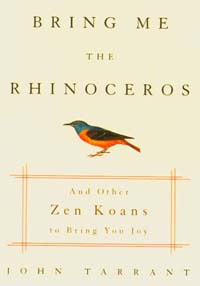Bring Me to the Rhinoceros: 
and Other Zen Koans to Bring You Joy
John Tarrant
New York: Harmony Books, 2004
160 pp.; $16.00 (paper)
I first discovered Buddhism the simple way. I wandered into a zendo out of curiosity, and soon found myself, day after day, sitting silently on a cushion following a teacher’s instructions to focus on my breath. These early experiences with meditation, though intriguing, quickly began to conjure more questions than they resolved. So I did what I normally do when I’m looking for answers: I went looking for an authoritative book.
I settled on the straightforward title Buddhism: An Introduction and Guide, by an English lawyer named Christmas Humphries. Humphries examined the history of Buddhism in the early twentieth century in the same dry manner that other Brits of his day studied the interior of Africa and the human diet. He delivered a carefully outlined tome from which I learned what Theravada meant, where Ceylon was, and why Zen was considered a form of Buddhism.
I suppose there is a place for such spiritual road atlases, but thankfully the bookshelves these days also contain more elegant, engaging introductions to Buddhist training. One is Bring Me the Rhinoceros, written by John Tarrant, an Australian-born Zen priest who lives in California.
The first tip-off to this little book’s understated elegance is its stated subject. It makes no claims to be a Buddhist primer. It’s a book about koans. These slippery little things have been passed on for centuries in the Japanese Zen tradition, from teacher to student, as a method of mind training.
Tarrant does not trumpet the koan as the precious hard-won product of centuries of esoteric Asian practice. Instead, he introduces the koan as the likable cousin of the modern poem, a handy tool to change one’s heart, to promote happiness, by evoking the unexpected through a word or a phrase.
Of course, Tarrant never actually says what a koan is. In the section “What Are Koans Exactly?” he comes close, explaining that a koan “is usually taken to refer to a riddle or an odd question,” but he gives no direct definition. By denying his readers the easy solution, Tarrant is already playing the Zen master. Like the koans he introduces, Tarrant provides few answers, just provocative questions for the reader to ponder again and again.
There’s the title koan about the Chinese teacher Yanguan. One day the teacher asks his trusty assistant to bring one of his possessions, a fan made of rhinoceros bone.
“The fan is broken,” responds the assistant.
“In that case,” says Yanguan, “bring me the rhinoceros.”
Upon hearing the teacher’s answer, Tarrant reports, the assistant was struck dumb, experiencing an insight into the narrowness of his own mind. Another koan hits its mark.
The book is written in eleven sections, each dedicated to telling and exploring a particular koan, mixing historical text and commentary along with Tarrant’s personal experiences and stories.
For those, like me, who have a hard time opening their minds to the surprise of the present moment, Tarrant’s explications often rival the koans themselves in providing opportunities for awakening. In his discussion of Songyuan’s koan “Why can’t clear-eyed Bodhisattvas sever the red thread?” Tarrant points out that passion and desire are key ingredients to developing empathy for others. By contrast, those who invoke religious purity often end up missing the point. What examples does Tarrant use to explore the danger of such rigidity? World Trade Center terrorist Mohammad Atta and Attorney General John Ashcroft, of course. Reading those names on opposite pages in a dharma book stopped my mind.
Exploring a koan about the simple wisdom of the ordinary mind, Tarrant paints an unforgettable scene of a lunchtime visit to the Beat poet Philip Whalen in his hospice room. Whalen is dying, but that one physical fact does not overwhelm him. Instead Whalen is quite present for the details of a simple lunch. “Unlike many Buddhists, he has not made a pretend Buddhist world to live in,” the author writes of Whalen. “He likes and dislikes this world with its physical pains and its pungent salami and the low, midday sun warming the window. He doesn’t yearn toward another world than this one.”
The same observation can be made of the spare, confident voice Tarrant brings to his volume. This is Buddhist writing at its liveliest and most potent; the kind I would recommend to a curious friend. It may not be a book for someone determined to get a few answers, but it is the ideal one for the person learning to live without them.